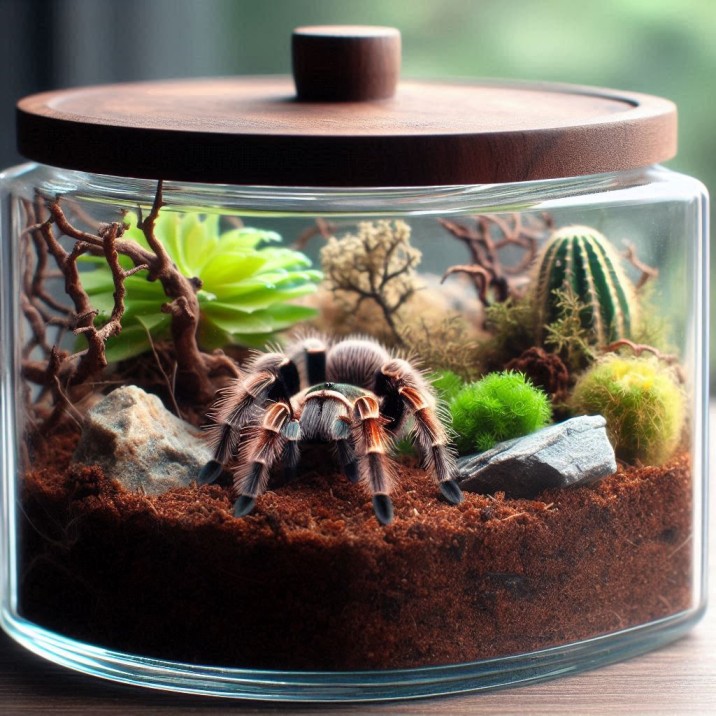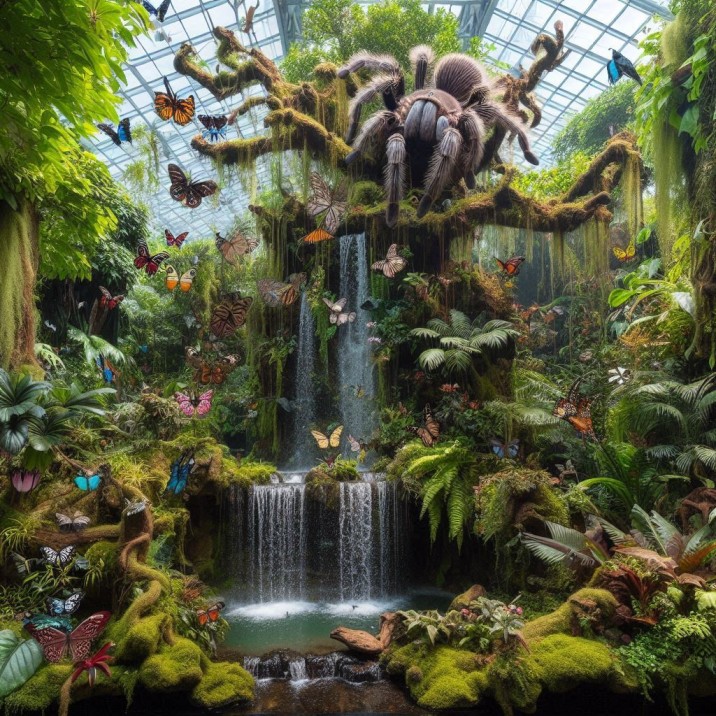Table of Contents
Table of Contents
- Introduction
- Overview of tarantula enclosure setup ideas
- Importance of a proper habitat
- Choosing the Right Enclosure
- Types of Enclosures
- Glass Terrariums
- Plastic Enclosures
- Acrylic Enclosures
- Pros and Cons of Each Type
- Types of Enclosures
- Setting Up the Enclosure
- Size Matters
- Small Enclosures
- Medium Enclosures
- Large Enclosures
- Ventilation
- Importance of Ventilation
- Methods for Ensuring Proper Airflow
- Size Matters
- Substrate Selection
- Types of Substrates
- Coconut Fiber
- Peat Moss
- Topsoil
- Substrate Depth
- Shallow Depth
- Moderate Depth
- Deep Substrate
- Types of Substrates
- Creating a Comfortable Habitat
- Hiding Spots
- Cork Bark
- Artificial Caves
- Flower Pots
- Climbing Structures
- Branches
- Plants
- Hiding Spots
- Maintaining Proper Humidity and Temperature
- Humidity Levels
- Low Humidity
- Moderate Humidity
- High Humidity
- Temperature
- Optimal Temperature Range
- Monitoring and Maintaining Temperature
- Humidity Levels
- Feeding and Watering Setup
- Water Dishes
- Shallow Dishes
- Water Bowls with Ramps
- Feeding Areas
- Designating a Feeding Spot
- Keeping the Enclosure Clean
- Water Dishes
- Enrichment and Decoration Ideas
- Natural Decorations
- Rocks and Pebbles
- Leaves and Moss
- Creative Themes
- Desert Theme
- Rainforest Theme
- Forest Floor Theme
- Natural Decorations
- Table of Information
- Quick Reference Table for Tarantula Enclosure Setup ideas
- FAQs about Tarantula enclosure setup ideas
- What is the best type of enclosure for a tarantula?
- How often should I change the substrate in a tarantula enclosure?
- Can tarantulas live together in the same enclosure?
- How do I maintain the right humidity for my tarantula?
- What is a good hiding spot for my tarantula?
- Conclusion
- Recap of key points
- Encouragement for setting up a comfortable tarantula habitat
Tarantula Enclosure Setup Ideas: A Comprehensive Guide
Introduction
Setting up a tarantula enclosure can be an exciting project, especially if you’re a new tarantula owner or looking to upgrade your pet’s habitat. It’s crucial to provide a safe, comfortable, and stimulating environment that mimics their natural habitat. This guide will explore various tarantula enclosure setup ideas that cater to different species, sizes, and needs. Whether you’re setting up an enclosure for a beginner tarantula or an exotic species, these ideas will help you create the perfect home for your eight-legged friend.

Choosing the Right Enclosure
Types of Enclosures
- Glass Terrariums
- Description: Glass terrariums are a popular choice due to their clarity and ease of customization.
- Pros: Great visibility, easy to clean, durable.
- Cons: Can be heavy and fragile.
- Plastic Enclosures
- Description: Lightweight and versatile, plastic enclosures are ideal for smaller tarantulas or those that prefer burrowing.
- Pros: Lightweight, inexpensive, and easy to modify.
- Cons: May scratch easily and can be less aesthetically pleasing.
- Acrylic Enclosures
- Description: Clear like glass but lighter, acrylic enclosures are a great middle-ground option.
- Pros: Lightweight, clear, and durable.
- Cons: More expensive than plastic, can be prone to scratches.
Setting Up the Enclosure
Size Matters
- Small Enclosures: Suitable for tarantulas under 2 inches. Ensure there’s enough space for movement.
- Medium Enclosures: Ideal for tarantulas between 2 to 4 inches. Provide ample room for web-building and burrowing.
- Large Enclosures: Best for tarantulas over 4 inches. Allow for plenty of space for exploration and activity.
Ventilation
Proper ventilation is crucial to prevent mold growth and maintain healthy humidity levels. Use mesh tops or drill holes in plastic and acrylic enclosures to ensure adequate airflow.
Substrate Selection
Types of Substrates
- Coconut Fiber
- Description: Also known as coco coir, it’s excellent for retaining humidity.
- Pros: Natural, retains moisture, easy to burrow.
- Cons: Needs regular maintenance to prevent mold.
- Peat Moss
- Description: A natural, absorbent substrate that is great for burrowing.
- Pros: Holds moisture, natural appearance, encourages burrowing.
- Cons: Can be messy, requires regular maintenance.
- Topsoil
- Description: Organic topsoil without fertilizers is a cost-effective substrate.
- Pros: Natural, cost-effective, good for burrowing.
- Cons: May contain insects, requires frequent replacement.
Substrate Depth
- Shallow Depth: 1-2 inches, suitable for arboreal tarantulas.
- Moderate Depth: 3-4 inches, ideal for terrestrial species.
- Deep Substrate: 5-6 inches or more, necessary for burrowing species.
Creating a Comfortable Habitat
Hiding Spots
- Cork Bark
- Description: Cork bark pieces provide natural hiding places and climbing surfaces.
- Pros: Natural look, lightweight, and easy to find.
- Cons: Can be expensive.
- Artificial Caves
- Description: Made of resin or plastic, these caves offer a durable hiding place.
- Pros: Durable, easy to clean, come in various sizes.
- Cons: Less natural-looking.
- Flower Pots
- Description: Inverted clay or plastic pots make simple and effective hiding spots.
- Pros: Inexpensive, easy to customize, widely available.
- Cons: Can be heavy, may require modification.
Climbing Structures
- Branches: Provide opportunities for climbing and mimic the natural habitat of arboreal tarantulas.
- Plants: Both live and artificial plants add a touch of nature and offer climbing surfaces.
Maintaining Proper Humidity and Temperature
Humidity Levels
- Low Humidity: 40-60%, suitable for desert species.
- Moderate Humidity: 60-70%, ideal for many terrestrial species.
- High Humidity: 70-80%, necessary for tropical species.
Use a hygrometer to monitor humidity levels and adjust as needed with misting or a water dish.
Temperature
Maintain a temperature range between 70-80°F for most tarantulas. Use a thermostat and heating mat if needed to keep the enclosure within the optimal range.
Feeding and Watering Setup
Water Dishes
- Shallow Dishes: Prevent drowning and are easy to clean.
- Water Bowls with Ramps: Provide a safe way for tarantulas to access water.
Feeding Areas
Designate a feeding spot to keep the enclosure clean and monitor your tarantula’s feeding habits. Remove uneaten food promptly to prevent mold and pests.
Enrichment and Decoration Ideas
Natural Decorations
- Rocks and Pebbles: Add a natural touch and provide additional climbing surfaces.
- Leaves and Moss: Enhance the natural appearance and help retain moisture.
Creative Themes
- Desert Theme
- Setup: Use sand, rocks, and cacti for a desert-like environment.
- Ideal for: Species like the Arizona Blonde Tarantula.
- Rainforest Theme
- Setup: Include live plants, moss, and high humidity elements.
- Ideal for: Species like the Brazilian Black Tarantula.
- Forest Floor Theme
- Setup: Use leaf litter, twigs, and cork bark to mimic a forest habitat.
- Ideal for: Species like the Mexican Redknee Tarantula.
Table of Information
| Aspect | Details |
|---|---|
| Enclosure Type | Glass, Plastic, Acrylic |
| Substrate | Coconut Fiber, Peat Moss, Topsoil |
| Humidity | Low: 40-60%, Moderate: 60-70%, High: 70-80% |
| Temperature | Optimal Range: 70-80°F |
| Hiding Spots | Cork Bark, Artificial Caves, Flower Pots |
| Climbing Structures | Branches, Plants |
| Feeding Area | Designated spot, clean promptly |
| Watering | Shallow dishes, water bowls with ramps |
| Decoration Themes | Desert, Rainforest, Forest Floor |
Conclusion
Creating the perfect tarantula enclosure involves careful planning and attention to detail. By considering the specific needs of your tarantula species, you can design a habitat that promotes their health and well-being. From choosing the right enclosure type to selecting suitable substrates and decorations, this guide provides a comprehensive overview of tarantula enclosure setup ideas. Remember, a happy tarantula is one that feels secure and comfortable in its environment. Happy setting up!
FAQs about Tarantula enclosure setup ideas
- What is the best type of enclosure for a tarantula? Answer: Glass terrariums are popular for their visibility and durability, but plastic and acrylic options are also great depending on your needs.
- How often should I change the substrate in a tarantula enclosure? Answer: It’s recommended to change the substrate every 6-12 months, or sooner if it becomes moldy or dirty.
- Can tarantulas live together in the same enclosure? Answer: No, tarantulas are solitary creatures and should be housed separately to avoid aggression.
- How do I maintain the right humidity for my tarantula? Answer: Use a hygrometer to monitor humidity levels and adjust with misting or a water dish as needed.
- What is a good hiding spot for my tarantula? Answer: Cork bark, artificial caves, and inverted flower pots make excellent hiding spots for tarantulas.

